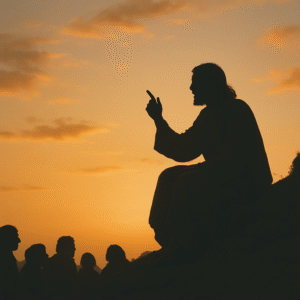The Lord’s Prayer has long been one of the most recognized and beloved prayers in the Christian tradition. For countless believers, it is not simply a recital but a deep spiritual connection, a model of devotion given by Jesus Himself. Its words echo through chapels, cathedrals, and households alike—reminders of faith, hope, and God’s presence.
The Origins of the Prayer
The prayer originates in the New Testament, where Jesus taught it during the Sermon on the Mount (Matthew 6:9-13). Another version appears in Luke 11:2–4, confirming its central role in His teaching. Picture the hillside setting: crowds gathered, eager for wisdom, and a teacher unlike any they had ever heard. It was there Jesus provided not just words, but a framework for prayer—a way to speak to God with honesty, reverence, and trust.
Line-by-Line Meaning
- “Our Father, who art in heaven”
Begins with intimacy and reverence. Calling God Father affirms closeness, while “in heaven” acknowledges His transcendence.
- “Hallowed be Thy Name”
A call to honor and revere God’s holiness, reminding us to keep sacred what is holy amidst daily life.
- “Thy Kingdom come, Thy will be done”
Expresses longing for a world shaped by God’s justice, love, and divine purpose. It’s both a prayer and a commitment to live aligned with His will.
- “Give us this day our daily bread.”
Extends beyond physical food to all we need—emotional, spiritual, and physical sustenance. It teaches us dependence on God’s daily provision.
- “Forgive us our trespasses, as we forgive those who trespass against us.
A powerful reminder of grace. We seek forgiveness for our failures while extending it to others, releasing the heavy burdens of resentment.
- “Lead us not into temptation”
A plea for guidance and wisdom, asking God to help us resist life’s pitfalls and make choices that reflect His values.
The Lord’s Prayer: A Roadmap for Stillness and Growth
Prayer isn’t just about words spoken into the air—it’s about transformation. It’s a pause in the chaos of life, a moment to step away from the noise and rediscover peace. Among the most well-known prayers in the world, The Lord’s Prayer is far more than a ritual. It is a roadmap for living—a guide toward awareness, gratitude, forgiveness, and compassion.
More Than Words
Each line of the prayer carries layers of meaning that invite reflection and contemplation.
- “Our Father” reminds us we’re not alone but part of something greater—a family, a story, a shared humanity.
- “Give us this day our daily bread” teaches gratitude, nudging us to notice the blessings already before us.
- “Forgive us our debts, as we forgive our debtors” challenges us to release resentment, extend grace, and break free from bitterness.
When prayed with intention, the words don’t just lift toward heaven—they reshape our hearts.
Prayer Meets Meditation
Meditation can become a powerful companion to prayer. Instead of rushing through the lines, pause for a moment. Let each phrase sink in. Ask yourself:
- How does “Your will be done” stretch my trust beyond my own plans?
- What fears am I bringing to “deliver us from evil”?
In that quiet space, prayer and meditation intertwine, opening doors to self-awareness and spiritual growth. Often, it is here—in stillness—that clarity comes for struggles, relationships, and life direction.
Forgiveness and Humility
Two golden threads run through The Lord’s Prayer: forgiveness and humility. These aren’t abstract ideals—they’re daily practices. Forgiveness might mean letting go of a harsh word spoken years ago. Humility may involve admitting fault and choosing to start anew. Each small act lifts invisible burdens, freeing us to live with compassion and an open heart, welcoming God’s love.
Simple Yet Profound
The beauty of this prayer lies in its balance: simple enough for a child to learn, deep enough for a lifetime of reflection. Integrating it into daily rhythms doesn’t require formality—just consistency. Whisper it in the morning to center yourself, or recite it at night to release the day. Pause after each line and ask: What does this mean in my life right now?
Over time, this practice shapes not only how we pray but how we live.
Living the Prayer
At its heart, The Lord’s Prayer is not about speaking words but embodying them:
- Seeking provision without greed.
- Forgiving without limits.
- Walking humbly with God.
- Holding faith steady when life feels overwhelming.
Each time we pray, we’re not only talking to God—we’re training our hearts in resilience, peace, and love.
A Prayer for the Ages: Its Relevance in Today’s World
The enduring relevance of The Lord’s Prayer lies in its simplicity and depth. It is both a whisper and a roar—quiet enough to steady an anxious heart, strong enough to unite entire communities across cultures and centuries. Its wisdom invites us not only to pray but also to live its truths: to forgive boldly, to give generously, to hope steadfastly, and to walk humbly with God.
In our fast-paced culture, where reflection is often drowned out by constant noise, returning to The Lord’s Prayer can be a grounding experience. It offers a rhythm, a slowing down, an invitation to remember what truly matters. Each line becomes a checkpoint for the soul: gratitude, forgiveness, humility, trust, and surrender. These aren’t abstract ideals; they are principles for resilience and hope, anchors that steady us through life’s storms.

